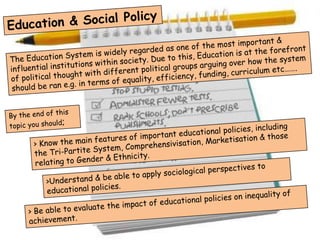
SociologyExchange.co.uk Shared Resource
- 1. Education & Social Policy The Education System is widely regarded as one of the most important & influential institutions within society. Due to this, Education is at the forefront of political thought with different political groups arguing over how the system should be ran e.g. in terms of equality, efficiency, funding, curriculum etc……. By the end of this topic you should; > Know the main features of important educational policies, including the Tri-Partite System, Comprehensivisation, Marketisation & those relating to Gender & Ethnicity. >Understand & be able to apply sociological perspectives to educational policies. > Be able to evaluate the impact of educational policies on inequality of achievement.
- 2. It all started with Industrialisation…. Industrialisation created the need for a trained, skilled, educated workforce. Before any formal Education System was put in place in the UK, schooling depended on social class… M/C families could afford to have their children privately educated whilst W/C families had to rely heavily on church-based & family-based basic education. This all changed with the introduction of the first ever Education Act in the UK…… The Forster Education Act 1870: This made Education compulsory from the ages of 5 – 11 years-old (raised to 13 y.o in 1880) in an attempt to Educate the masses & eliminate the social class divide. Parents now had a choice of 3 types of school to send their children: The key to studying Policies: > What is the Policy? > What problems does it identify? > What improvements does it aim to make & how? > Was/ Is it effective? Elementary School Grammar School (Fees) Public School (Fees)
- 3. Although the Forster Act 1870 tried to eliminate Social Class inequality in education, this only catered for children up to the age of 13/14 y.o. As such, once pupils left their first schools it was the M/C that were able to go into Secondary schooling (again creating Social Class Inequalities). This changed with the introduction of…. The Butler Education Act 1944: World War II was reaching an end & the emphasis in the UK was to create ‘A land fit for heroes’. The Conservative Government thus ‘Opened Up’ Secondary Education to the masses i.e. reduce Social Class Inequalities within Education. As a result the R.A Butler 1902 - 1982 was introduced…. Tri-Partite System Secondary Modern School The idea here was to produce ‘Parity of Esteem’ (Equality of Opportunity) between the social classes – Meritocratic Ideology. Technical School ‘Primary Schooling’ 11+ Exam Grammar School
- 4. Secondary Modern School W/C > Are there any problems with using exams to measure ability.? Technical School W/C ‘Primary Schooling’ 11+ Exam Grammar School M/C Evaluation of the Butler Act & the Tri-Partite System: This system actually recreated the social class divide rather than eliminate it…… > Revise your notes on Social Class differences in Education (External & Internal Factors) > M/C Children had better Primary Schooling thus were better prepared for the 11+ Exam. > The 11+ used M/C Elaborated Language (See Bernstein) > The negative Stigma attached to Secondary Modern Schools created a negative Self-Fulfilling Prophecy for the W/C pupils. > Teachers were lower paid in Secondary Modern Schools & thus arguably less Qualified/ Motivated. > Regardless of 11+ Results, M/C parents could still afford to pay for Public Schooling. > Secondary Modern Schools had poorer resources & facilities due to lack of income.
- 5. Due to the problems that the Tri-Partite caused for the W/C, it was replaced in the 1960s by the newly installed Labour Government which aimed to create Equality once again amongst the social classes. Comprehensivisation 1965 James Callaghan (PM) 1976 This created the Comprehensive schools that are so popular nowadays. The biggest clue as to what ‘Comprehensive’ Schooling is all about can be seen in the following definition: Harold Wilson (PM) 1964 & 1974 ‘Comprehensive’: meaning Covering or Involving Much; Inclusive – (Dictionary.com) Comprehensive Schools are schools that everyone attends regardless of ability or social class. The 11+ was abolished and a child’s schooling depended upon their ‘Catchment Area’. This aimed to ensure that all pupils would get ‘Parity of Esteem’ & ‘Equality’ within education as they would have the same teachers, same resources, same facilities, same funding etc … Despite these good intentions however, Comprehensivisation does have it’s downfalls…….
- 6. Evaluationof Comprehensivisation: With all pupils in one school, it was important to make sure all abilities were catered for & as such Setting & Streaming were introduced. What problems do Setting & Streaming create? (Revise notes on Labelling/ Interactionist Explanations of Social Class differences in Education) Streaming Setting Geo. Geo. Sci. Sci. Mat. Mat. Eng. Eng. Remember, ‘Evaluation’ means looking at the advantages of the argument (not just the disadvantages) X X Stream 1 Set 1 X Set 2 Stream 2 X Set 3 > Individual Talents get over-looked Stream 3 > High-Flyers are held back by lower ability pupils & vice-versa > M/C areas get M/C comprehensive Schools –W/C get W/C Schools. > M/C parents could still afford to pay for Public Schooling. > It was the choice of LEAs to ‘Go Comprehensive’ – therefore M/C/ Conservative LEAs could opt out of it & continue with the 11+ ‘Grammar School’ route.
- 7. Another policy that was introduced in the 1960s to address social class inequality within education was….. Educational Priority Areas 1965 It was recognised that, although comprehensive schools aimed at closing the social class divide in education, working class areas were home to working class schools These ‘deprived’ schools were listed as ‘Priority Schools’ & accordingly they received additional funding & resources to compensate. This is known as . Positive Discrimination How might pupils react when their school is labelled as a ‘Priority School’. How could a deprived, low-achieving school be helped out by the government?